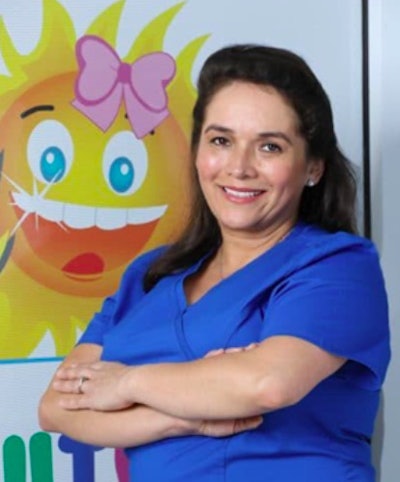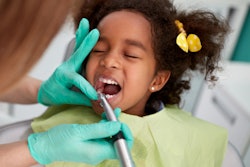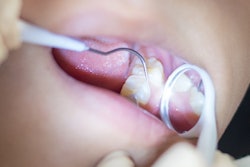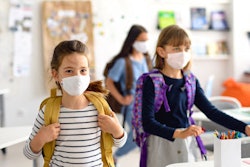
Thousands of dentists treating children across the U.S. are facing a new dilemma as they reopen their doors in a post-COVID-19 world. In a sea of change, how do dentists keep children feeling steady before, during, and after dental treatment?
Establishing and regaining the trust of young patients is essential for a successful experience for all involved. Here are eight tips that I believe can help ensure a smooth visit for children, parents, and the dental team.
1. Take time to plan how your office will reassure patients
 Catalina Botero, DDS.
Catalina Botero, DDS.Millions of Americans find going to the dentist to be a scary thing. In fact, even for adults, feelings of anxiety and fear can skyrocket at just the thought of that visit. Now consider how a child may feel visiting a dental office for the first time, or after all the COVID-19 changes have been implemented.
Children are much more sensitive to change. Their feelings of fear and anxiety can quickly escalate if proper preparation and anticipation of their needs isn't taken into consideration. As a result, dentists who are reopening their doors post-COVID-19 are charged with taking their specialized skills to a new level. To succeed, they must be intentional with their process. Taking the time to identify patient/caregiver concerns and address how to resolve them can make all the difference.
2. Schedule a mask-free FaceTime visit before the appointment
The first time a child sees his or her dentist's face shouldn't be with half of it covered with a mask. Dentists should consider scheduling a FaceTime call with young patients before their appointments to allow them a chance to meet/reconnect with their dentist without the mask.
A child is going to feel more secure with a pediatric dentist if that child senses that the dentist truly cares for him or her. Attentive, kind, patient care is paramount to helping children feel safe when they walk into their new dental home.
Because so much of how we feel is communicated with our smiles and facial expressions, masks can make it difficult for children to break through and connect with their treatment provider. A FaceTime visit is a great opportunity to learn more about how your pediatric patient is doing, what that child is most excited about with the upcoming visit, and maybe what some of his or her fears are before he or she comes to the office. By the way, it's a great time to do a pre-COVID-19 screening too.
It is also a perfect opportunity to display the different personal protective equipment (PPE) a child will see at the office, such as a face shield, face mask, eye protection, etc., and explain how it works to keep everyone protected.
3. Communicate beforehand what a child and caregiver can expect
Children aren't the only family members who need reassurance. Parents and caregivers need to know what changes are in place to keep their children safe. Dentists should take time to explain how they are maintaining Occupational Safety and Health Administration (OSHA) and Centers for Disease Control and Prevention (CDC) guidelines for infection control. Also, they should explain the new protocols parents and patients can expect to see when they return to the office.
Here are some common new protocols that dentists need to educate patients and caregivers on prior to the appointment:
- Preappointment screening. Upon arrival, assistants will ask the parent to complete a brief screening form for the scheduled child. Anyone entering the practice will have his or her temperature taken with a digital, no-touch thermometer.
- Curbside waiting room. The standard waiting room is now a curbside waiting room. Additional guests, other than the patient, are asked to wait in their car for the duration of the appointment to support proper social distancing guidelines. Patients wait to be called in from their car for an appointment once the previous patient is gone and sanitation is complete.
- One guardian with a patient. Only one guardian per family accompanies patients to their appointment. The parent is required to wear his or her own mask for the duration of the time he or she is in the office. The guardian's temperature will also be taken upon arrival.
- Welcome table instead of waiting room. A welcome table will be waiting for patients when they arrive. At the welcome table, they will be asked to use the hand sanitizer provided, complete the screening form, and have temperatures taken.
- Staggered appointments. Patient appointments will be staggered to help support social distancing precautions.
- Aerosol spray containment strategies. Rubber dams will be used during treatment to contain spray. Dental hygienists have a dental assistant help them and use a high-volume evacuator (HVE) for hygiene procedures.
- If symptomatic, reschedule. Patients will be asked to reschedule all appointments if they or anyone in the household isn't feeling well.
With all of this education, it is imperative that dentists (and staff) remember to talk on a level appropriate for each child. Help them understand what is happening in a way that is less intimidating.
4. Ramp up the office cheer
Now is the time to ramp up the cheer in your office. Children aren't used to visiting their dental home with so many masks and face shields. While a child can't see the smiles of office staff, they can see smiling eyes, hear happy tones, and find comfort in positive energy.
Take the time to brainstorm with staff about how you can improve and maintain office cheer. Invest in upbeat music, a warm color scheme, and cartoon or animal art to help a child feel more comfortable.
Make directional signs and 6-ft social distancing floor markers fun. Kids will enjoy following signs and standing on specified spots when they have a creative twist to them.
Consider decorating the digital thermometer and assigning it a fun personality. A prepared dialogue can put a child at ease when staff take his or her temperature.
5. Maintain a kid-friendly feel
Whether patients are visiting the dentist for the first time or a checkup, dentists and staff need to ensure there is a fun and friendly environment waiting so that children have the best experience. I believe we should treat every patient as if he or she is our own child.
While most dental offices are eliminating a waiting room, dentists can create an inviting welcome area where the child and caregiver check in. Instruct parents before the appointment that siblings should stay at home. Only one caregiver should be present with the child during the appointment to help reduce the new occupancy load of the office.
Also, eliminate toys and office iPads/computers. Instead, ask families to bring their own fidget aids to help reduce office contamination with shared devices/toys. Kids can bring devices to watch their favorite shows and movies during treatment. This distracts them and improves their cooperation during treatment.
6. Choose PPE with child-friendly patterns/colors
Just because dentists and staff need to wear masks doesn't mean they can't try and make masks colorful and fun. When possible, do what you can to make your PPE more light-hearted and fun. Superhero themes are a popular way to go to communicate friendliness from behind the mask.
7. Introduce your sanitization/disinfection technicians
Educating young patients and their caregivers on the steps you are taking to keep them safe can do wonders in helping them feel safe. Take the time to introduce them to new faces you may have around the office. Introduce them to your sanitization and disinfection technicians. Help them understand that these friendly, roaming dental assistants sanitize all areas of concern.
8. Eliminate toy bins, but not the toys
Kids love their postappointment rewards. While toy bins make it hard to control the passing of germs between patients, that doesn't mean the dental office can't still offer kids a choice of a toy after treatment. Have a list or picture flyer of reward options that staff can retrieve and give to the child.
An engaged dentist works to make a child feel safe and secure when they are at the practice. Now more than ever, this is an essential skill all patients (and staff) need. Incorporating these post-COVID-19 tips can help restore patient confidence in the dentist and go a long way in reinforcing healthy connections.
Catalina Botero, DDS, currently practices at Li'l Sunshine Smiles Dentistry in Tampa, FL, specializing in children's services. She was born and raised in Colombia. There, she attended the University of Antioquia, one of the most prestigious universities in South America. After dental school, Dr. Botero moved to Florida to further her dental education, eventually attending the University of Colorado and obtaining her second degree as a dentist.
The comments and observations expressed herein do not necessarily reflect the opinions of DrBicuspid.com, nor should they be construed as an endorsement or admonishment of any particular idea, vendor, or organization.



















